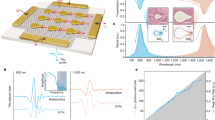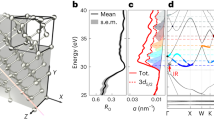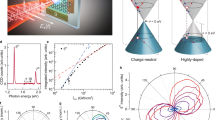Abstract
Light-driven electronic excitation is a cornerstone for energy and information transfer. In the interaction of intense and ultrafast light fields with solids, electrons may be excited irreversibly, or transiently during illumination only. As the transient electron population cannot be observed after the light pulse is gone, it is referred to as virtual, whereas the population that remains excited is called real1,2,3,4. Virtual charge carriers have recently been associated with high-harmonic generation and transient absorption5,6,7,8, but photocurrent generation may stem from real as well as virtual charge carriers9,10,11,12,13,14. However, a link between the generation of the carrier types and their importance for observables of technological relevance is missing. Here we show that real and virtual charge carriers can be excited and disentangled in the optical generation of currents in a gold–graphene–gold heterostructure using few-cycle laser pulses. Depending on the waveform used for photoexcitation, real carriers receive net momentum and propagate to the gold electrodes, whereas virtual carriers generate a polarization response read out at the gold–graphene interfaces. On the basis of these insights, we further demonstrate a proof of concept of a logic gate for future lightwave electronics. Our results offer a direct means to monitor and excite real and virtual charge carriers. Individual control over each type of carrier will markedly increase the integrated-circuit design space and bring petahertz signal processing closer to reality15,16.
This is a preview of subscription content, access via your institution
Access options
Access Nature and 54 other Nature Portfolio journals
Get Nature+, our best-value online-access subscription
$29.99 / 30 days
cancel any time
Subscribe to this journal
Receive 51 print issues and online access
$199.00 per year
only $3.90 per issue
Buy this article
- Purchase on Springer Link
- Instant access to full article PDF
Prices may be subject to local taxes which are calculated during checkout




Similar content being viewed by others
Data availability
Source data are provided with this paper.
References
Yablonovitch, E., Heritage, J. P., Aspnes, D. E. & Yafet, Y. Virtual photoconductivity. Phys. Rev. Lett. 63, 976–979 (1989).
Yamanishi, M. Field-induced optical nonlinearity due to virtual transitions in semiconductor quantum well structures. Phys. Rev. Lett. 59, 1014–1017 (1987).
Schultze, M. et al. Controlling dielectrics with the electric field of light. Nature 493, 75–78 (2012).
Sommer, A. et al. Attosecond nonlinear polarization and light–matter energy transfer in solids. Nature 534, 86–90 (2016).
Lucchini, M. et al. Attosecond dynamical Franz–Keldysh effect in polycrystalline diamond. Science 353, 916–919 (2016).
Schlaepfer, F. et al. Attosecond optical-field-enhanced carrier injection into the GaAs conduction band. Nat. Phys. 14, 560–564 (2018).
Jürgens, P. et al. Origin of strong-field-induced low-order harmonic generation in amorphous quartz. Nat. Phys. 16, 1035–1039 (2020).
Sanari, Y. et al. Role of virtual band population for high harmonic generation in solids. Phys. Rev. B 102, 041125 (2020).
Schiffrin, A. et al. Optical-field-induced current in dielectrics. Nature 493, 70–74 (2012).
Higuchi, T., Heide, C., Ullmann, K., Weber, H. B. & Hommelhoff, P. Light-field-driven currents in graphene. Nature 550, 224–228 (2017).
Chen, L., Zhang, Y., Chen, G. & Franco, I. Stark control of electrons along nanojunctions. Nat. Commun. 9, 2070 (2018).
Langer, F. et al. Few-cycle lightwave-driven currents in a semiconductor at high repetition rate. Optica 7, 276 (2020).
Garzón-Ramírez, A. J. & Franco, I. Symmetry breaking in the Stark control of electrons at interfaces (SCELI). J. Chem. Phys. 153, 044704 (2020).
Hanus, V. et al. Light-field-driven current control in solids with pJ-level laser pulses at 80 MHz repetition rate. Optica 8, 570 (2021).
Krausz, F. & Stockman, M. I. Attosecond metrology: from electron capture to future signal processing. Nat. Photon. 8, 205–213 (2014).
Markov, I. L. Limits on fundamental limits to computation. Nature 512, 147–154 (2014).
Kruchinin, S. Y., Krausz, F. & Yakovlev, V. S. Colloquium: Strong-field phenomena in periodic systems. Rev. Mod. Phys. 90, 1–27 (2018).
Ma, Q. et al. Direct optical detection of Weyl fermion chirality in a topological semimetal. Nat. Phys. 13, 842–847 (2017).
Jiménez-Galán, Á., Silva, R. E. F., Smirnova, O. & Ivanov, M. Lightwave control of topological properties in 2D materials for sub-cycle and non-resonant valley manipulation. Nat. Photon. 14, 728–732 (2020).
Bai, Y. et al. High-harmonic generation from topological surface states. Nat. Phys. 17, 311–315 (2021).
Ishikawa, K. L. Nonlinear optical response of graphene in time domain. Phys. Rev. B 82, 201402 (2010).
Heide, C., Boolakee, T., Higuchi, T. & Hommelhoff, P. Adiabaticity parameters for the categorization of light–matter interaction: from weak to strong driving. Phys. Rev. A 104, 023103 (2021).
Boolakee, T. et al. Length-dependence of light-induced currents in graphene. J. Phys. B 53, 154001 (2020).
Zhang, Y., Chen, S. & Chen, G. First-principles time-dependent quantum transport theory. Phys. Rev. B 87, 085110 (2013).
Malic, E., Winzer, T., Bobkin, E. & Knorr, A. Microscopic theory of absorption and ultrafast many-particle kinetics in graphene. Phys. Rev. B 84, 205406 (2011).
Gierz, I. et al. Snapshots of non-equilibrium Dirac carrier distributions in graphene. Nat. Mater. 12, 1119–1124 (2013).
Franco, I. & Brumer, P. Minimum requirements for laser-induced symmetry breaking in quantum and classical mechanics. J. Phys. B 41, 074003 (2008).
Floss, I., Lemell, C., Yabana, K. & Burgdörfer, J. Incorporating decoherence into solid-state time-dependent density functional theory. Phys. Rev. B 99, 224301 (2019).
Neufeld, O., Tancogne-Dejean, N., de Giovannini, U., Hübener, H. & Rubio, A. Light-driven extremely nonlinear bulk photogalvanic currents. Phys. Rev. Lett. 127, 126601 (2021).
Heide, C. et al. Electronic coherence and coherent dephasing in the optical control of electrons in graphene. Nano Lett. 21, 9403–9409 (2021).
Tetienne, J. P. et al. Quantum imaging of current flow in graphene. Sci. Adv. 3, e1602429 (2017).
Tan, S. et al. Coherent electron transfer at the Ag/graphite heterojunction interface. Phys. Rev. Lett. 120, 126801 (2018).
Heide, C. et al. Attosecond-fast internal photoemission. Nat. Photon. 14, 219–222 (2019).
Fortier, T. M. et al. Carrier-envelope phase-controlled quantum interference of injected photocurrents in semiconductors. Phys. Rev. Lett. 92, 147403 (2004).
Garg, M. et al. Multi-petahertz electronic metrology. Nature 538, 359–363 (2016).
Röhrl, J. et al. Raman spectra of epitaxial graphene on SiC(0001). Appl. Phys. Lett. 92, 201918 (2008).
Emtsev, K. V. et al. Towards wafer-size graphene layers by atmospheric pressure graphitization of silicon carbide. Nat. Mater. 8, 203–207 (2009).
Castro Neto, A. H., Guinea, F., Peres, N. M. R. R., Novoselov, K. S. & Geim, A. K. The electronic properties of graphene. Rev. Mod. Phys. 81, 109–162 (2009).
Kelardeh, H. K., Apalkov, V. & Stockman, M. I. Graphene in ultrafast and superstrong laser fields. Phys. Rev. B 91, 045439 (2015).
Gabor, N. M. et al. Hot carrier-assisted intrinsic photoresponse in graphene. Science 334, 648–652 (2011).
Shautsova, V. et al. Plasmon induced thermoelectric effect in graphene. Nat. Commun. 9, 5190 (2018).
Mueller, T., Xia, F., Freitag, M., Tsang, J. & Avouris, Ph. Role of contacts in graphene transistors: a scanning photocurrent study. Phys. Rev. B 79, 245430 (2009).
Woessner, A. et al. Near-field photocurrent nanoscopy on bare and encapsulated graphene. Nat. Commun. 7, 10783 (2016).
Zheng, X., Wang, F., Yam, C. Y., Mo, Y. & Chen, G. Time-dependent density-functional theory for open systems. Phys. Rev. B 75, 195127 (2007).
Lui, C. H., Mak, K. F., Shan, J. & Heinz, T. F. Ultrafast photoluminescence from graphene. Phys. Rev. Lett. 105, 127404 (2010).
Vampa, G. et al. Theoretical analysis of high-harmonic generation in solids. Phys. Rev. Lett. 113, 073901 (2014).
Song, J. C. W., Tielrooij, K. J., Koppens, F. H. L. & Levitov, L. S. Photoexcited carrier dynamics and impact-excitation cascade in graphene. Phys. Rev. B 87, 155429 (2013).
Brida, D. et al. Ultrafast collinear scattering and carrier multiplication in graphene. Nat. Commun. 4, 1987 (2013).
Acknowledgements
We thank Y. Morimoto, J. Ristein and M. Hundhausen for discussions. This work has been supported in part by the Deutsche Forschungsgemeinschaft (SFB 953 ‘Synthetic Carbon Allotropes’, project number 182849149), the PETACom project financed by Future and Emerging Technologies Open H2020 program, ERC Grants NearFieldAtto and AccelOnChip, the Leonard Mandel Faculty Fellowship of the University of Rochester, and the US National Science Foundation under grant numbers CHE-1553939 and CHE-2102386.
Author information
Authors and Affiliations
Contributions
T.B. and C.H. conveyed the current measurement experiments, analysed the data, performed TDSE simulations and provided the plots. A.G.R. and I.F. conducted the TD-NEGF simulations. H.B.W. provided the tools for sample fabrication. All authors discussed the obtained results and contributed to the writing of the manuscript. I.F. and P.H. co-supervised the study. T.B. and C.H. contributed equally.
Corresponding authors
Ethics declarations
Competing interests
The authors declare no competing interests.
Peer review
Peer review information
Nature thanks the anonymous reviewers for their contribution to the peer review of this work.
Additional information
Publisher’s note Springer Nature remains neutral with regard to jurisdictional claims in published maps and institutional affiliations.
Extended data figures and tables
Extended Data Fig. 1 Electric field and vector potential of Gaussian laser pulses used for simulations.
The maximum field strength is 2.3 V/nm, the pulse duration is 6 fs (intensity FWHM), the centre photon energy is 1.5 eV. a, For a CEP φCE = π/2 the electric field is antisymmetric with respect to time inversion while the vector potential is symmetric. b, For φCE = 0 the electric field is symmetric and the vector potential is antisymmetric.
Extended Data Fig. 2 Sample and measurement technique.
a, Scanning electron micrograph of the gold–graphene–gold heterostructures with various electrode distances. The yellow colouring indicates the gold electrodes. Insets, total photocurrent as a function of the focal position inside the dashed regions (E0 = 0.3 V/nm). For all measurements and unless otherwise stated, the laser spot was positioned in the centre of the graphene strips such that the total photocurrent is 0. b, Schematic diagram of the measurement scheme. The induced residual current is amplified by transimpedance amplifiers and detected by a dual-phase lock-in amplifier.
Extended Data Fig. 3 Total photocurrent and CEP-dependent current on an L=1 μm graphene strip as a function of E0.
a, Total photocurrent with the laser focus placed at the interface (compare with current maxima in Extended Data Fig. 2a, inset). b, CEP-dependent current for φCE=π (same data as in Fig. 2c). Insets show the data in a double-logarithmic scale with linear fits, while shaded points only are included in the fit in (b).
Extended Data Fig. 4 CEP dependence of currents for logic switching.
a, Measured and simulated CEP-dependent current (blue, data and simulation as in Fig. 4b) and lock-in phase (purple). The shaded range ΔφCE=[–2π, 0] is further analysed in (c), where it is mapped to ΔφCE=[0, 2π]. b, Using Eq. (8) of Methods, the Δφg dependence of the current is exemplified for two data points (light and dark green) of (a). Dashed lines indicate the root mean square values, i.e., the currents shown in (a). c, Measured current as a function of ΔφCE and demodulated along Δφg. The light and dark green lines correspond to the data points marked in (a) and analysed in (b). d, Simulated current as a function of ΔφCE and Δφg. The model curve of θ (purple line) is indicated with an arbitrary offset with respect to (a). e, Measured current (c) in the basis of individual CEPs φA and φB. f, Simulated current in the same basis as (e).
Extended Data Fig. 5 Realization of various logic gates.
a, Simulated CEP-dependent current as a function of φA and φB with equal current amplitudes JA, JB induced by laser pulses A (bulk graphene) and B (interface). The purple crosses mark phases φA, φB considered in (b). b, CEP-dependent current for 16 combinations of φA and φB as needed for the operation of logic gates. Positive current is assigned to an output logic level Y of 1 while zero or negative current is assigned to 0 (see colour bar). The green dots mark the combinations required for the formation of the logic gates shown below. c–f, Truth tables of AND (c), OR (d), NAND (e) and NOR (f) are obtained by appropriate choice of CEPs φA and φB as marked in (b). The green arrows (rings) on the insets depicting the heterostructure mark the current direction (zero current) driven on the graphene and at the interface.
Extended Data Fig. 7 Optical near-field simulation of the heterojunction.
a, Schematic of the structure used in finite-difference time-domain simulations. Two electrodes consisting of 5 nm titanium and 30 nm gold separated by a 1 μm graphene strip are supported by a SiC substrate. Similar to experimental conditions, the structure is illuminated with a Gaussian focus placed in the centre. b, Field enhancement ξ within the graphene layer (red line). In the centre, ξ reaches the analytic factor given by the polarization response of bare SiC (grey dashed line) while it rises to 2 in the optical near-field of the electrodes. c, Variation of the CEP ΔφCE across the graphene strip. ΔφCE is independent of the exact value of the CEP.
Extended Data Fig. 8 Line-scan of CEP-dependent current.
Measured CEP-dependent currents are plotted as a function of the focus position that is moved from one to the other gold electrode (shaded areas) across a 5 × 1.8 μm2 graphene strip on an axis centred to the graphene strip width. The current projections j±π/2 (purple data points) and j0,π (blue data points) are shown. A peak field strength of E0 = 2.7 V/nm is applied. Error bars indicate the standard deviation.
Extended Data Fig. 9 Transient evolution of charge motion and electron population obtained from a TDSE model.
a, b, Charge motion for a CEP of φCE = π/2 (a) and φCE = 0 (b). The grey lines show the electric field of the pulses with E0 = 2.3 V/nm, centred at t = 0. c, d, Normalized electron population ρQ contributing to the charge transfer. The population is normalized to the number of available states in the first Brillouin zone of graphene. For φCE = 0, ρQ returns to zero after the pulse is gone, while for φCE = π/2, a residual population remains and leads to an increasing charge transfer, see also insets.
Extended Data Fig. 10 Two-pulse experiment.
CEP-stable laser pulses from a Ti:Sa oscillator are split into pulse copies (A, B) in a Michelson interferometer. The SiO2 wedge pairs are used to balance the dispersion (path A and B), and to vary ΔφCE (path A). The temporal delay is changed by variation of path length A. Introducing an angle in path B results in spatially separated foci on the sample, see microscope image. BS, beam splitter; OAP, off-axis parabolic mirror.
Supplementary information
41586_2022_4565_MOESM1_ESM.mp4
Supplementary Video 1 Extraction of lock-in observables in the two-pulse scheme. a, Simulated net currents induced by laser pulses A (jA, orange) and B (jB, red) are modulated as a function of Δφg, and additionally, the phase of jA is shifted continuously by ΔφCE. Their superposition (jtotal, blue) is the signal fed into the dual-phase lock-in amplifier, where the root-mean-square value of jtotal (J, horizontal blue line) and its phase θ are measured as a function of ΔφCE. b, Simulated current amplitude J (blue) and its phase θ (purple), as extracted experimentally by the lock-in amplifier.
Rights and permissions
Springer Nature or its licensor holds exclusive rights to this article under a publishing agreement with the author(s) or other rightsholder(s); author self-archiving of the accepted manuscript version of this article is solely governed by the terms of such publishing agreement and applicable law.
About this article
Cite this article
Boolakee, T., Heide, C., Garzón-Ramírez, A. et al. Light-field control of real and virtual charge carriers. Nature 605, 251–255 (2022). https://doi.org/10.1038/s41586-022-04565-9
Received:
Accepted:
Published:
Issue Date:
DOI: https://doi.org/10.1038/s41586-022-04565-9
This article is cited by
-
Femtosecond electron beam probe of ultrafast electronics
Nature Communications (2024)
-
All-in-one, all-optical logic gates using liquid metal plasmon nonlinearity
Nature Communications (2024)
-
Sub-cycle multidimensional spectroscopy of strongly correlated materials
Nature Photonics (2024)
-
Light-driven nanoscale vectorial currents
Nature (2024)
-
Light-wave-controlled Haldane model in monolayer hexagonal boron nitride
Nature (2024)
Comments
By submitting a comment you agree to abide by our Terms and Community Guidelines. If you find something abusive or that does not comply with our terms or guidelines please flag it as inappropriate.



